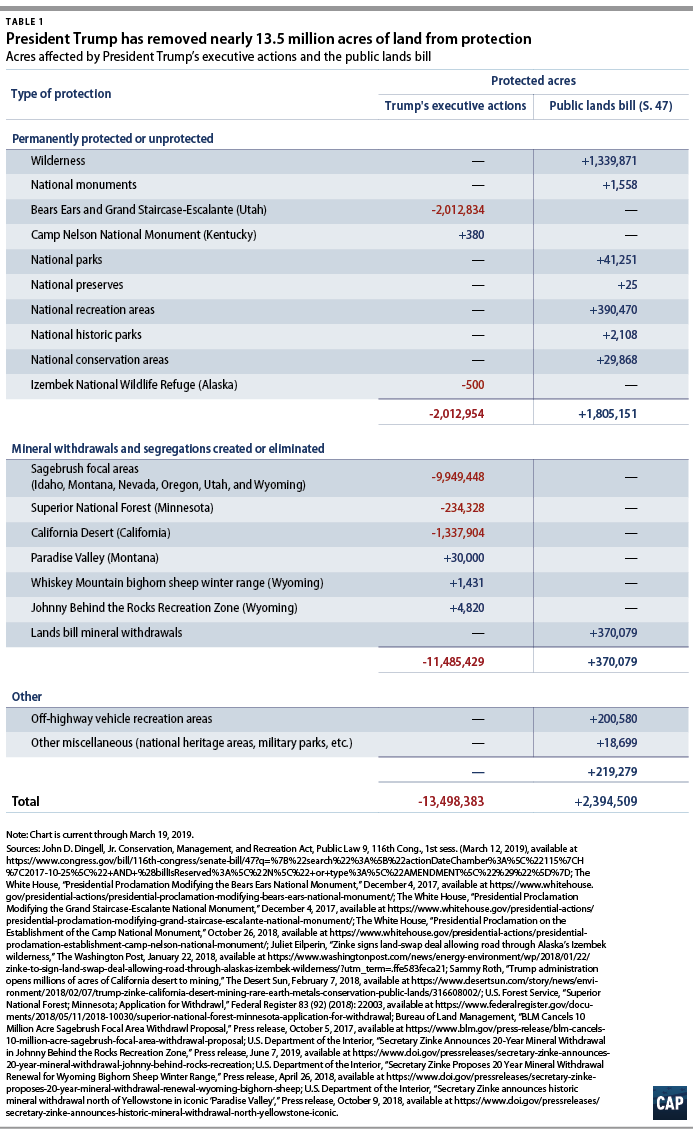On March 12, 2019, President Donald Trump signed into law a sweeping, bipartisan public lands bill that permanently protects nearly 2.4 million acres of public lands and water. The John D. Dingell Jr. Conservation, Management, and Recreation Act creates five national monuments, protects more than 1.3 million acres of wilderness, expands two national parks, and blocks more than 370,000 acres of public lands from mining.
David Bernhardt, the acting secretary of the U.S. Department of the Interior and nominee to become the permanent secretary, was quick to claim credit for the bill before President Trump signed it into law. But the duo was largely absent through the bill’s advancement, at times even actively working against some of its provisions. For instance, the bill permanently reauthorizes the Land and Water Conservation Fund, a program that uses revenues from offshore oil and gas drilling to protect parks, rivers, and forests across the country. But Trump’s fiscal year 2020 budget proposal, released just a day before he signed the public lands bill, proposes gutting the popular program.
Congress, not the Trump administration, deserves the credit for this law’s passage. It worked in a bipartisan fashion to craft and pass a package of lands and wilderness bills that are overwhelmingly popular with the American public, and the bill passed the House of Representatives and Senate with formidable majorities.
Meanwhile, a new Center for American Progress analysis shows how Trump’s executive actions have put him well in the red when it comes to conserving America’s lands and waters—which he claimed he’d protect—both for permanent land protections and for mineral withdrawals. In fact, the administration has spent its time in office stripping protections from a staggering 13.5 million acres of American lands and waters.

The Trump administration’s pattern of undermining conservation measures and public lands protections
In its most well-known attack on public lands, the Trump administration removed more than 2 million acres from Bears Ears and Grand Staircase-Escalante national monuments—culminating in the largest elimination of protected areas in U.S. history. Then, in January 2018, the U.S. Department of the Interior approved a plan to build a road straight through the previously wild Izembek National Wildlife Refuge in Alaska.
In October 2018—just two months before he resigned amid a slew of scandals—former Interior Secretary Ryan Zinke sought to garner hometown praise by withdrawing 30,000 acres from mining north of Yellowstone National Park in Montana. But Zinke, Trump, and Bernhardt have overturned far more acres of mineral withdrawals than they have protected. Other sensitive landscapes that the administration has opened to mining include: nearly 10 million acres of sage-grouse habitat; the watershed of the Boundary Waters Canoe Area Wilderness; and lands bordering Joshua Tree and Death Valley national parks in the California desert.
The administration’s anti-conservation agenda shows no signs of slowing
The Trump administration is unlikely to stop its assault on public lands at 13.5 million acres. In its quest for “energy dominance,” the administration has a number of other projects in the works opening more lands to development and devastating wildlife habitat.
Drilling in big game habitat
Acting Interior Secretary Bernhardt is giving lip service to protecting big-game wildlife corridors ahead of his nomination hearings in a thinly veiled attempt to shore up support from the sportsmen community. In reality, though, the Interior Department’s Bureau of Land Management (BLM) continues to sell off state-identified wildlife priority areas for big game to the oil and gas industry.
Continued attacks on sage-grouse habitat
Last week, the Trump administration finalized major changes to the 2015 sage-grouse conservation plans, at the behest of special interests in the oil and gas industry. The changes gut vital protections for the sage-grouse and ignore the overwhelming public input urging the BLM to honor the 2015 plans. Furthermore, at the end of February, the BLM held a lease sale where every parcel offered was within sage-grouse habitat. In fact, 10 of the parcels were located within the Golden Triangle region, which has the highest density of sage-grouse in the world.
Opening the Arctic Refuge to drilling
President Trump’s 2017 tax bill opened the entire coastal plain of the Arctic National Wildlife Refuge to oil drilling. Bernhardt and the Interior Department have since worked at breakneck speed to open the refuge, one of the country’s last great wildernesses, to the oil industry as soon as this year.
Drilling the majority of the U.S. coastline
The Interior Department’s Bureau of Ocean Energy Management is expected to release its new proposed offshore drilling plan soon, which could open up 90 percent of the U.S. coast to drilling—despite widespread opposition from communities up and down the Atlantic and Pacific coasts. Berhnardt has the final signoff, but the plan is expected to open the entire Atlantic coastline to offshore drilling. His assistant secretary for land and minerals management, Joe Balash, told The Washington Post that the agency is working to obtain seismic permits off the Eastern Seaboard for this very purpose. Balash went so far as to call it “absolutely thrilling” that President Trump’s media distractions have allowed his agency to process permits without public scrutiny.
Conclusion
The Trump administration has already effectively ceded the United States’ long-standing role as a global leader in conservation. And with David Bernhardt in the wings to become the next secretary of the Interior Department, the trendline is unlikely to change direction. During Bernhardt’s upcoming confirmation hearing, senators must question whether he is dedicated to protecting public lands, or instead—as his track record indicates—to opening up millions of acres to development.
Jenny Rowland-Shea is a senior policy analyst for Public Lands at the Center for American Progress. Mary Ellen Kustin is the director of policy for Public Lands at the Center.
The authors would like to thank Carlos Rivero Lopez, Nicole Gentile, Shanee Simhoni, Meghan Miller, Will Beaudouin, and Keenan Alexander for their contributions to this column.